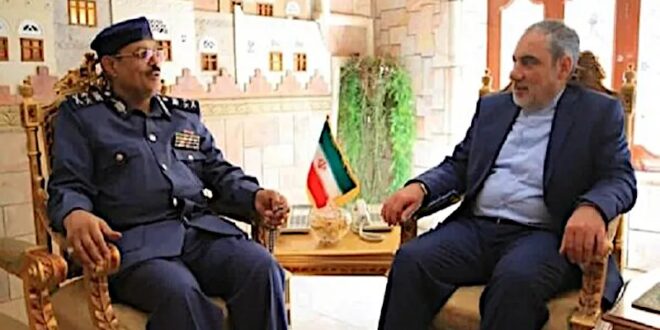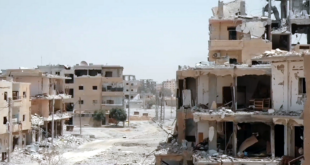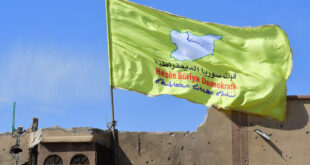Iran infiltrated the Yemeni arena by pursuing the same strategy it has found useful since the mid-1980s. Iran’s leadership is well aware that Yemen’s authorities, for several reasons, are unable to provide it with the amount of territory it seeks to seize in the country. This led Tehran to bypass the official level, operating instead in a “gray zone” at the nonstate level through its allied proxies inside Yemen.
Iran has helped its proxies in every way possible in Yemen, especially in Sanaa and the northern provinces, even managing to establish a foothold in the Zaidi Shiite community, particularly among the Jarudiyah minority. This infiltration — coupled with the ideological influence of Twelver Shiism on the Houthi’s leadership — led to this community’s doctrine being undermined, with Tehran’s proxies managing to incorporate some tenets of Twelver Shiism into Zaidi Islam.
Iran’s infiltration into Yemen poses a greater and graver danger compared to the Sudanese arena, especially in light of the Tehran-affiliated armed proxy groups, which are effectively remotely controlled by Iran.
Following the 1979 Iranian revolution, Yemen received significant attention in the geographic, cultural and religious spheres due to the presence of the Zaidis. They account for nearly a third of Yemen’s population.
Iran is waging battles throughout the region, driven by its obsession with Islamic leadership and exporting its theocratic revolution aimed squarely at the Arab region.
It views the Houthi group as its newest regional partner, one that could — along with its other proxy groups in Lebanon, Syria and Iraq — play an effective role in enabling it to achieve its political and sectarian ambitions.
Iran constantly instigates the Houthis — directly or indirectly — to initiate rebellion and disobedience, while depicting themselves as a downtrodden and oppressed community.
The Iranians are indifferent to the fact that Twelver Shiism heaps a myriad of accusations on the followers of Zaidi Islam, denouncing those who link the two sects, since Zayd ibn Ali is not one of the 12 imams venerated by Twelver Shiites.
Conversely, Zaidi clerics similarly denounce Twelver Shiism, asserting that it “deviated from the right path.”
These points make it clear that Iran’s interest in the Houthi group and the Zaidi faction in Yemen is purely politically motivated and linked to its expansionist schemes. Despite these obvious irreconcilable differences, Iranian media outlets promote the Houthis and support them through biased reporting about the Yemeni arena.
Iran’s media openly speaks of and lauds the links between the Houthi group and Tehran, proclaiming that the group’s success is considered to be indicative of Iran’s success in achieving its regional objectives, including those in Syria.
The same media is working hard to polish the Houthis’ image and present it to the Iranian public as a wise and moderate group unconnected to any violence, sectarian disputes or narrow, exclusionary ideologies.
When the Houthis swept across Sanaa, Iran’s media did not even mention it, instead focusing on a Shiite Friday prayer event led by one imam in a predominantly Sunni region south of Sanaa. According to the Iranian media, this event provided evidence that the Houthi group was capable of leading and representing all Yemeni factions.
Iran’s media has also been keen to prove the peaceful nature of Yemeni Shiites by reporting that the Houthis did not use, carry or take up arms during their anti-government rallies — but this is easily disproved by viewing any photos or footage of the rallies.
Tehran is keen to draw comparisons between the Houthis and the Lebanese Hezbollah. Iran’s creation of Hezbollah led to a sizable Israeli military presence on Lebanon’s southern border, making Iran a northern neighbor of the Israeli occupiers by proxy.
Based on the same logic, Iran may become the southern neighbor of Saudi Arabia, allowing it to put greater direct pressure on the Kingdom in relation to the region’s political equations.
This issue was addressed recently by Ali Akbar Velayati, the former Iranian foreign minister and political adviser to the supreme leader. Velayati boasted of a unique transformation in Yemen’s history, asserting that the Houthis’ consecutive victories indicate that their operations were well planned. Velayati voiced hope that the Houthis would play a similar role in Yemen to that of Hezbollah in Lebanon, asserting that the latter fights alongside the Lebanese army against those threatening Lebanon. Velayati added that Iran considers the Houthi group in Yemen to be part of the “Islamic awakening.”
Over the past two decades, Iran succeeded in infiltrating Yemen through attracting some Zaidi students, particularly those ideologically close to the Houthis. Iran granted these students scholarships at Iranian universities, where they were molded, influenced and indoctrinated to reflect the Iranian regime’s political orientations and to embrace its version of Twelver Shiism.
Iran also managed to attract influential leaders from within the Zaidi community in Yemen, such as Badreddin Al-Houthi and his sons. These leaders converted to Twelver Shiism and promoted this doctrine across the Zaidi community. In addition, Iran provided financial support in the Zaidi-majority regions, with the aim of wooing the locals.
Yemen is of the utmost importance for Iran, with Twelver Shiites believing that the pivotal figure Al-Yamani — who, according to their doctrine, will appear prior to Imam Mahdi and provide him with support when he appears — will emerge from the land of Yemen.
At the political level, Yemen watchers are well aware of the intensity of Iran’s involvement in the country through the support it provides to the Houthis, embedding sleeper cells and attempting to smuggle large quantities of weapons. Iran also established and supported television channels working for the Yemeni opposition in Syria and Lebanon.
Despite the compelling and overwhelming evidence provided by the Yemeni security services of Iranian involvement, Tehran has, predictably, categorically denied everything, dismissing all evidence as false accusations.
Iran’s leadership believes that, if Shiites and the Houthis emerge victorious from the conflict in Yemen, two remarkable events will take place there. Firstly, a massively powerful semi-independent state would be established in northern Yemen, with international approval, with Saada as its capital. Secondly, according to the same calculations, a Shiite-dominated central government would be installed in Yemen, turning Sanaa into a powerful ally of Iran.
At the historical level, Tehran is highlighting the differences between Egypt and Yemen on the one hand and between Saudi Arabia and Yemen on the other, especially during the second half of the 20th century, which witnessed the removal of the imamate government.
The Iranians have portrayed this event as a clash between leftist or socialist forces and what Iran refers to as “reactionary forces.” Iranian media also repeatedly refers to the tensions that impacted Saudi-Yemeni relations and the battle that broke out between Saudi forces and the Houthis in Jabal Al-Dukhan on the Saudi-Yemeni border in 2009. It promotes a skewed narrative to deepen the animosity between Yemen (ruled by the Houthis) and Saudi Arabia. The Houthi group was portrayed as having emerged victorious against the Saudi army, attracting sympathy and support from some segments of Yemeni society and conferring on it a nationalist dimension.
Another thread in Iranian media coverage invokes the historical ties between Iran and Yemen, starting from the sixth century Achaemenid Empire, then through the Sassanid and Fatimid dynasty epochs. The Pahlavi dynasty, as well as the so-called Islamic Republic, did not change trajectory and maintained the historical ties between Iran and Yemen.
According to this historical narrative — in reference to its Arab and Iranian protagonists — the main point is to depict Iran as a party that is keen to establish an independent and progressive Yemeni state, playing up the positive services provided by Iran to Yemen through history. It also paints a relentlessly negative picture of Yemen’s relations with other Arab countries, especially Saudi Arabia, which is portrayed as a reactionary enemy seeking to destroy Yemen, fearful of Yemenis’ wit and power and keen to prevent any positive development in the country, which could impact the Kingdom in one way or another.
At the regional level, in addressing the situation in Yemen, Iran has heavily emphasized the Arab nationalist dimension of the disputes among Arab tribes, represented by northern and southern Arabs respectively, before and since the advent of Islam. Iran’s rhetoric asserts that Yemen is the cradle of Arabs, depicting Yemenis as being particularly intelligent, unlike other Arab peoples. This is an attempt to stir up tribal and factional sensitivities or prejudices in Yemen toward the other Arab tribes and peoples in the Arabian Peninsula, with Tehran well aware of the regional sensitivity regarding tribal issues and history and the importance accorded to these matters in Yemeni society in particular.
As for the Iranian/Persian nationalist dimension, Iran has focused on the historical monuments associated with Persian civilization in Yemen and all the countries overlooking the Red Sea, highlighting the cultural and civilizational presence of the Persian empires in this region. This is a very calculating strategy used to play on the nationalist heartstrings of the Iranian street and to nurture the dreams of resurrecting the Sassanid dynasty, which is always present in the Persian ultranationalist mindset, with many hoping that this dream may come true.
In this respect, we are well aware that the form of Twelver Shiism adopted by Iran’s leaders has added a nationalist dimension to the religious one, with Yemen likely to play a crucial role in any future Mahdi state.
In geopolitical terms, meanwhile, Iran focuses on Yemen’s strategic location, with Tehran keenly alert to the country’s maritime significance — from a geographic perspective — due to the vast proportion of global maritime traffic passing through the Bab Al-Mandab Strait and the Gulf of Aden. Tehran also believes that any presence in southern Yemen means it can exert greater control over the Strait of Hormuz and gain a foothold in the Arabian Sea, with the aim of increasing the number of levers available to it through which it can threaten to close down vital waterways, potentially causing chaos in the global energy markets.
Another crucial reason for Yemen’s importance to Iran is its status as a neighbor to its regional archrival, Saudi Arabia. Tehran seeks, through the support it provides to the Houthis deployed on the Saudi-Yemen border, to maintain a foothold near its rival’s land border. Some Iranian media statements and semi-official comments from prominent figures suggest that the Houthis’ control over large swathes of Yemeni territory makes Iran the de facto southern neighbor of Saudi Arabia. Regardless of Iran’s aims behind these provocative statements, they underline the crucial geopolitical significance that Yemen represents to the Iranian regime.
On balance, the major world powers’ willful blindness and heedlessness toward Tehran’s support for and sponsorship of terrorism is extremely dangerous. Any decision by the US to return to the nuclear deal, which has been clearly hinted at, would most definitely lead to more violence and instability in the region. The terrible suffering of the people of Iran would drag on, since the lifting of sanctions would encourage Iran to increase its financial and military support for its militias, rather than positively impact the living standard of the Iranian people — an experience seen all too clearly following the 2015 nuclear deal. Unless wisdom prevails among the world powers, the future for Yemen and the region looks bleak.
 Eurasia Press & News
Eurasia Press & News




